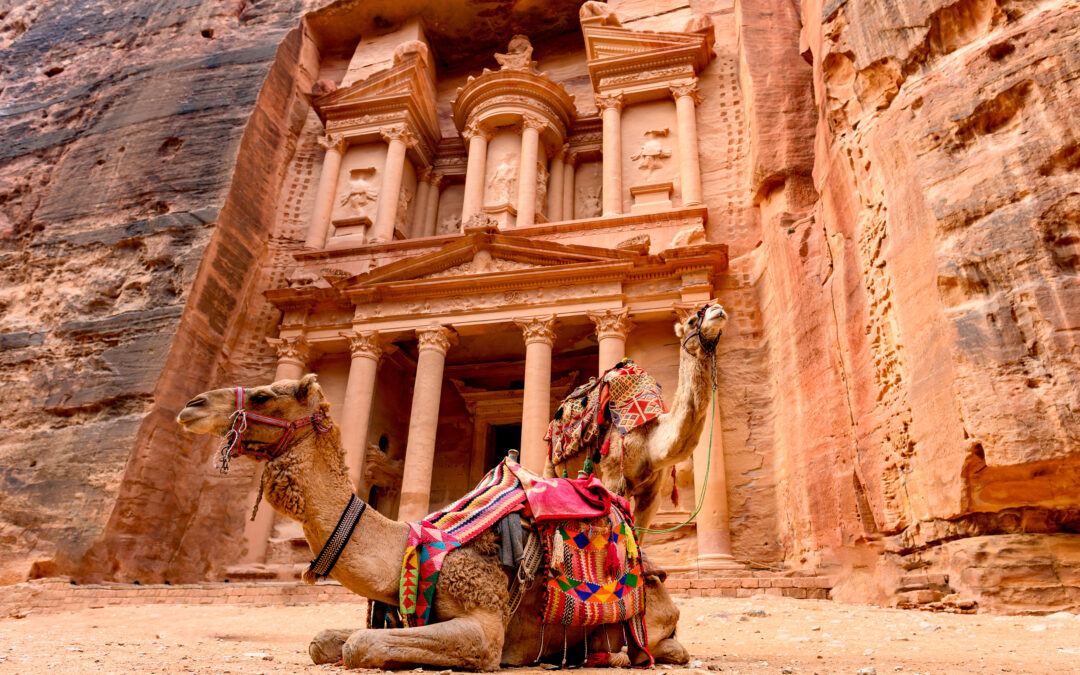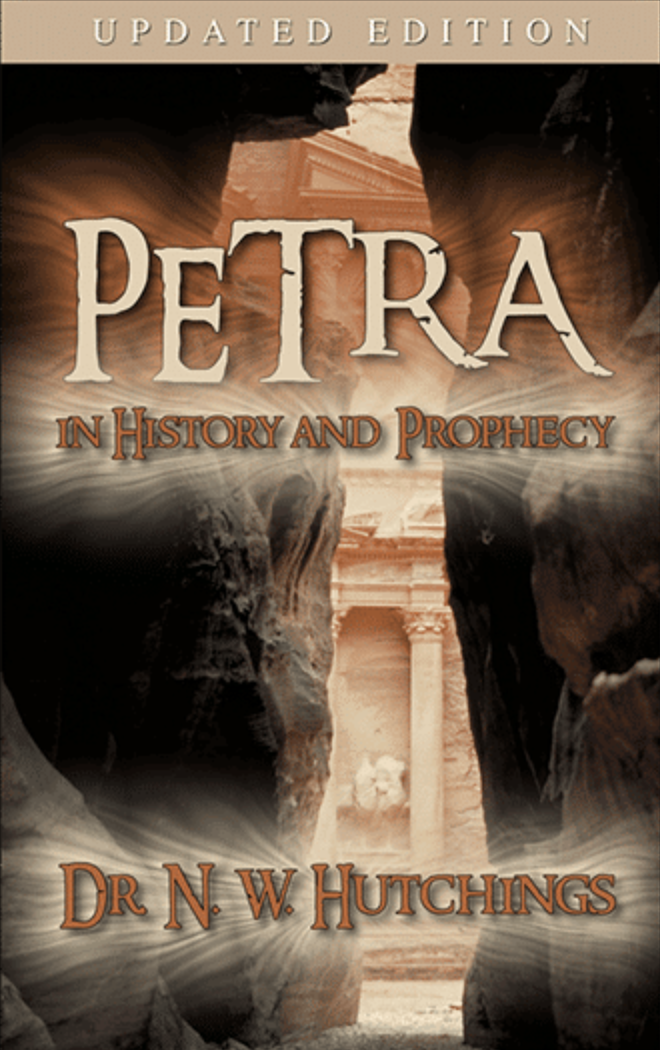Most tourists who visit the ancient city of Petra will surely agree that it is the most amazing “ghost town” on Earth. We have seen the pyramids of Egypt, the temples of Luxor and Karnak, the Parthenon, Delos, Ephesus, Knossos, Babylon, Nineveh, Ur, and hundreds of other sites and cities of antiquity, but nothing surpasses the beauty and splendor that must have belonged to Petra. And because many of the temples and dwellings were carved out of sandstone rock cliffs, the physical aspects of this Edomite metropolis remain for the visitor’s appraisal and inspection today.
Petra is located about 180 miles south of Amman and 75 miles north of Aqaba in Jordan. Its biblical names are Mount Seir and Sela. Mount Hor is also associated with the general area in Scripture. Petra is also described by the prophets as the rocky nest of the eagle, the city of Esau, and the stronghold of the Edomites.
Few Christians realize just how many times Petra is mentioned in the Bible, and the important role it played in biblical history. Even fewer realize that God is preparing to resurrect this historical ghost town to serve as a hiding place for Israel. In this study, we will show beyond reasonable doubt that Petra will be the place of safety that one-third of the Jews will escape to from the wrath of Antichrist. Therefore, we believe these dissertations on the place of Petra in history and prophecy are of great importance.
Most visitors and tourists to Petra today are Americans who go there because of the relation of the city to Bible history and prophecy. To get to Petra, tourists usually go as members of a group, and enter Jordan one of two ways – either by airplane to the airport at Amman, or through Israel by way of the Allenby Bridge checkpoint. It is usually necessary to stay overnight at a hotel in Amman, and there are now several five-star hotels in the Jordanian capital, almost as good as can be found anywhere. The journey to Petra the following day can be negotiated one of two ways. The most economical way is by bus via the King’s Highway, or the Desert Road. However, by motor vehicle it is a four-hour journey through a semidesert area devoid of any worthwhile scenery save a few wandering camels and an occasional Bedouin tent.
I recommend a route that is quicker and more scenic. From Amman, take the early morning Jordanian airline flight to Aqaba. Flying time is about 30 minutes. An air-conditioned bus will pick the Petra-bound tourists up at the airport, and the traveler will be treated to a 90-minute journey of mountainous fantasy. This plain is dotted with pyramid-shaped geological formations, and in the evening twilight, an eerie and ethereal appearance is projected. When Lawrence of Arabia passed through this area in World War I, he named it the Valley of the Moon. It was through this unusual valley that Moses led the children of Israel up to the gates of Petra when the king of Edom refused them permission to pass through to the King’s Highway that led from the mountains of Gilead that overlooked the Promised Land.
The city of Petra – named in 2007 as one of the seven wonders of the world – is entered through one of the most fantastic rock formations on earth, El Ciq. About two miles from the entrance to the Ciq is Ain Musa (the Spring of Moses). At one time, water from Ain Musa was carried into the city by tile pipe inlaid in the rock walls of the Ciq. Some of these tiles are still embedded in rock, and the channel that was chiseled in the cliffs is still very much in evidence. We shall consider the possibility that Ain Musa is actually one of the two rocks that Moses struck to bring forth water later in this study. It is remarkable that at the peak of the Mount Seir mountain range in the desert area, springs of pure and sweet water pour from rock formations. According to The Sarcophagus of an Ancient Civilization, the water lines and channels that diverted water from Ain Musa and other springs in the area are of Roman construction; however, we can be sure that prior inhabitants of Petra also availed themselves of these water sources.
Although rainfall in the area is only a few inches annually, at times cloudbursts create floods that sweep through the Ciq, drowning anyone caught in its path.
With the fall of the Roman Empire came a lack of necessary forces to keep law and order in that part of the world. Therefore, the rise of marauding bands and changing trade routes affected the future of the city. In about A.D. 600, Petra again became an isolated city, a home only for vagabonds and wild Arab tradesmen. While it is true that the Crusaders did make an appearance at Petra in the 12th century, and even built a small castle structure within the city, their influence was inconsequential, and they seemed content to concentrate their efforts farther north at their main castle, Al Karak, adjacent to the Dead Sea.
For over 1,000 years Petra remained a ghost town. Those from the outside world who heard of its existence and former glory only half-believed that there ever was such a city. During this time, the Roman Empire fell; the Huns invaded Europe; Columbus discovered America; the Protestant Reformation occurred; European powers established the world colonial system; the Napoleonic wars occurred, as well as the French and American revolutions; and the U.S. became a nation.
In 1812, John L. Burckhardt, a Swiss adventurer, set out from Cairo, Egypt, determined to find out if the city of Petra was truth or fancy. He had prepared himself by learning Arabic and the basic rituals and beliefs of the Muslim religion. He went first to Syria and turned southward to Philadelphia, which is present-day Amman. He was informed that being a foreigner, he would be killed by the Arabs before he reached his destination. Therefore, he disguised himself as a devout Muslim determined to offer a sacrifice at the tomb of Aaron. He was led by a guide down through the Ciq, past the Treasury Building, into the heart of Petra. Burckhardt’s discovery soon led others to this ancient rock city that had been lost in time for 1,000 years.
Since 1950, thousands of visitors from all over the world have gone to Petra, the yearly numbers depending upon the political and military situation in the Middle East. However, the city itself, for the most part, remains a ghost town, awaiting patiently its next inhabitants, whom we believe to be a Jewish remnant who will live here for three and a half years, watching for the coming of Messiah.
Petra in Prophetic Perspective
We believe Petra will become of prophetic importance in the day when:
• Israel will become a nation again and win miraculous victories against overwhelming odds. This has occurred.
• A great nation to the north of Israel called Gog in Ezekiel 38-39 will move with a great army over the mountains of Israel to take a “great spoil.” Most Bible scholars interpret this nation to be Russia.
• Israel’s flight to Petra will come three and one-half years after the signing of a Middle East comprehensive peace treaty (Dan. 9:27).
• Petra will again loom into prominence when knowledge has increased, along with accelerated communications and travel (Dan. 12).
• Petra would be readied for its role in the last days when the Roman Empire would be revived and a world government leader would demand that everyone on Earth worship him as a god (Rev. 13).
• The Abomination of Desolation will be the signal for Israel to flee to Petra – in a time when all the world is working, buying and selling using code marks and numbers (Rev. 13). The world has just about arrived at this economic stage.
The preceding and many other prophetic signs in evidence today serve as signals for the ancient city of Esau to prepare for an influx of visitors, the children of Jacob.
This article is an excerpt from PETRA in History and Prophecy by Noah Hutchings
Petra in History and Prophecy
Petra is the most amazing ghost town in the world, and, we believe, Israel’s hiding place during the last half of the Tribulation.
Petra is mentioned more times in the Bible than any other city, with the exception of Jerusalem. You will be amazed at the volume of scripture relating to this rock city of twenty square miles, located in southern Jordan just a few miles from Israel’s border.
Petra is a fascinating and important place in coming events. It will be a witness to Israel, both now and during the coming time of Jacob’s trouble.
Noah Hutchings
Rev. Noah Hutchings had served as both president and radio host of Southwest Radio Ministries from 1988 to 2015. He wrote dozens of books and booklets on prophecy and other Bible themes. Rev. Hutchings was also active in missions and communications ministries for over 40 years and led mission tours to Israel, Iraq, Egypt, Europe, Russia, China, Mongolia, and many other nations around the world. Brother Hutchings went home to be with the Lord in June 2016.



What amazing and absolutely astonishing to be able to see that ancient city. So very interesting to read this excerpt on my tablet with great letters.
I would love to have been able to visit Petra, but, no money and nobody I can go with if I had the money. Being 76 year widow.
I have very bad eyes to read a book with small letters. Maybe there will be an audio book soon?
When the letters are a bit bigger I love to order the book.
I am Dutch but can read and understand English thank God.
I believe the enemy of Israel/Jacob, has always been esau, edom…true hate..
I have researched Jacob and Esau and Tribes of Israel 20 some years ago and astonished at how churches have no clue about these stories that so important! Especially in the last days. The churches are silent as usual on many issues! So i did and do my own studies. Esau is a plague of Jacob’s latter day descendants! They rule the world and are destroying it…So irritating. And it is unreal how the so called Christians
have no clue and ignore it! Thank you for this Petra article…It is valuable to know about it.